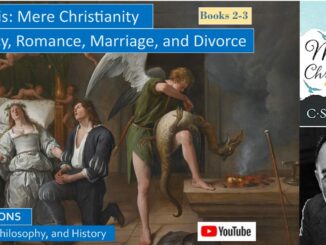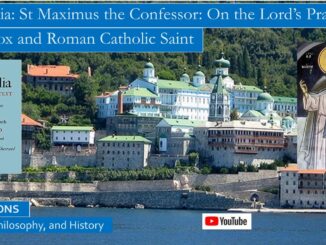
When the Russian pilgrim in the spiritual classic, “The Way of a Pilgrim,” hears the Scriptures being read that exhorts us to pray without ceasing. He asks a monk in a monastery how he can pray without ceasing, and the simple answer is he can start on his path by each day praying more. He selling all he has, giving it to the poor, to embark on a spiritual pilgrimage, trudging through the forests of Siberia. His only possessions in his travel bag are the Holy Scriptures and the Philokalia, the treasured writings of the early Greek Church Fathers.
Please view our YouTube video on this topic, this also includes some history and selections from the glossary not in this blog: https://youtu.be/rKVBhdHWHGI
The Philokalia is well known in the Eastern Orthodox and Byzantine Catholic Churches. Although the Philokalia is written to give monks guidance on living the monastic life, many laypeople treasure the teachings of the Philokalia as they apply to all devout Christians. Since the monastic life is a selfless life, since the monastic life is not a life you live only for yourself, any Christian calling is a monastic calling, including the calling to be a teacher, a parent, a loyal spouse, a nurse of doctor, teacher or manager, or simply to live an ordinary life as a worker or student. Very few who live in the world can keep up the prayer cycles of monks, but they can pray ceaselessly by living a godly life always and observing a daily rule of prayer. Even the layman can learn to pray the Jesus prayer of the hesychast, “Lord Jesus Christ, Son of God, have mercy on me, a sinner.”
The translators quote from the original introduction by St Nikodimos, “Unceasing prayer should be practiced by all. Naturally, the monastic life provides conditions, such as quietness, solitude and regularity, indispensable for that concentration without which one cannot advance far along the spiritual path.” As long as the layman participate in the Divine Liturgy and partakes of the sacraments, “this path is open to all to follow, each to the best of his or her ability and whatever the circumstances under which he or she lives.”[1]
In this blog we will reflect on the introduction written by the translators in Volume 1 of the Greek Philokalia and selected articles from a scholarly anthology of articles about the Philokalia, which includes histories of the Greek, Russian, Romanian and other Philokalia collections. The original compilers wanted to preserve those monastic writings that contained key teachings so they would not be later lost in the sands of history. Some influential monastic works were not included, perhaps because they were so well-known and plentiful, including works by the Cappadocian Church Fathers, St Isaac the Syrian, St Gregory Palamas, St John Chrysostom, St Dionysius the Areopagite, and St John Climacus, author of the Ladder of Divine Ascent.[2]
In their introduction, the translators of the English version tell us the meaning of the Philokalia. “Philokalia itself means love of the beautiful, the exalted, the excellent, understood as the transcendent source of life and the revelation of Truth. It is through such love that, as the subtitle of the original edition puts it, ‘the intellect is purified, illumined and made perfect.’ . . . The Philokalia shows the way to awaken and develop attention and consciousness, to attain that state of watchfulness which is the hallmark of sanctity.” “The Philokalia is an itinerary through the labyrinth of time, a silent way of love and gnosis through the deserts and emptiness of modern life, a vivifying and fadeless experience.” The Philokalia is a “summons to man to overcome his ignorance, to uncover the knowledge that lies within, to rid himself of illusion, and to be receptive to the grace of the Holy Spirit who teaches all things and brings all things to remembrance.”[3]
Kallistos Ware tells us that St Nikodimos of the Holy Mountain was inspired by “a love of hesychia, of stillness and solitude,” inspired by Christ’s teaching that the ‘Kingdom of God is within you, and by an evangelism of the pen as he sought to spread the teachings studied by the monks on Mount Athos. What is missing, and avoided, in the Philokalia, is the modern bias against ancient tradition, the modern desire to be creative and inventive. The key works in the Philokalia are the works of St Evagrios and St Maximus the Confessor, these works are the foundation on which the entire Philokalia stands. The works in each volume borrow from the works in the preceding volumes, adding additional observations and teachings, but striving to retain the style and tempo of the original writings. Many of the works in the Philokalia sound alike because they share so much, you did not need to footnote your sources because they were the foundation of your works.
The Eastern tradition encourages you to empty your mind of thoughts when you are deep in contemplative prayer. The introduction quotes St Evagrios’ work on Prayer, “When you are praying, do not shape within yourself any image of the Deity, and do not let your intellect be stamped with the impress of any form; but approach the Immaterial in an immaterial manner, and then you will understand.”
Kallistos Ware lists three master themes in the Philokalia:
- “Nepsis, a key concept in Eastern Christian spirituality, signifies inner sobriety, lucidity, alertness, watchfulness, and vigilance.” St Hesychios in “On Watchfulness” links Nepsis with “attentiveness, purity of heart, guarding of the intellect, the Jesus prayer, stillness, and contemplation.”
- The second master theme is “hesychia, which is stillness or silence of the heart,” and is also the “shedding of thoughts, at type of inner nakedness, of noetic poverty.” Kallistos Ware clarifies that not all prayer is hesychast prayer
- The states of Nepsis and hesychia are needed to properly pray the Jesus prayer, “the remembrance and invocation of the Holy Name of Jesus. “The Jesus prayer enables the intellect, or nous, to descend into the heart, or kardia, bringing about a union between the two.” The Philokalia emphasizes that “the invocation of the Name of Jesus should be as far as possible continuous, for its purpose is precisely to assist us to pray without ceasing (I Thess. 5:17).” The Jesus prayer “should be as far as possible unaccompanied by images and discursive thinking, for its aim is equally to initiate us into hesychia.”[4]
What awes and impresses me when I read the Philokalia is how Loving God with all of our heart and with all of our soul and with all of our mind and with all of our strength is constantly intertwined with loving of our neighbor as ourselves, being eager to forgive our neighbor of his faults and transgressions, as St Maximus the Confessor so often reminds us in his works. Which reminds me of the country song, “You Don’t Love God if you don’t love your neighbor.”
The Love of our Beautiful Lord in the Philokalia recalls the loving and longing song of the Psalmist in Psalm 42 and 84:
“As a hart longs for flowing streams,
so longs my soul for thee, O God.
My soul thirsts for God, for the living God.
When shall I come and behold the face of God?”[5]
How lovely is thy dwelling place, O Lord of hosts!
My soul longs, yea, faints for the courts of the Lord;
my heart and flesh sing for joy to the living God.[6]
For a day in thy courts is better than a thousand elsewhere.
I would rather be a doorkeeper in the house of my God
than dwell in the tents of wickedness.[7]
Worshipping the Lord and serving the Lord is a joy if you truly Love God with all of your heart and with all of your soul and with all of your mind, and if you love your neighbor as yourself.
[1] GEH Palmer, Phillip Sherrard, and Kallistos Ware, “Introduction,” In the Philokalia, The Complete Text, compiled by St Nikodimos of the Holy Mountain and St Makarios of Corinth, Vol. 1, (London: Faber and Faber, 1979), pp. 14-16.
[2] Kallistos Ware, “St Nicodemus and the Philokalia,” in the Philokalia, A Classic Text of Orthodox Spirituality (New York: Oxford University Press, 2012), p. 20.
[3] GEH Palmer, Phillip Sherrard, and Kallistos Ware, “Introduction,” In the Philokalia, pp. 13-14.
[4] Kallistos Ware, “St Nicodemus and the Philokalia,” in the Philokalia, A Classic Text of Orthodox Spirituality (New York: Oxford University Press, 2012), p. 18, 27-32.
[5] https://www.biblegateway.com/passage/?search=psalm+42%3A1-2&version=RSVCE
[6] https://www.biblegateway.com/passage/?search=psalm+84%3A1-2&version=RSVCE
[7] https://www.biblegateway.com/passage/?search=psalm+84%3A10&version=RSVCE







2 Trackbacks / Pingbacks